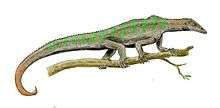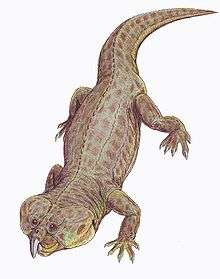Ornithischia
| Ornithischians Temporal range: Late Triassic–Late Cretaceous, 231.4–66 Ma | |
|---|---|
 | |
| Diversity of ornithischian dinosaurs. | |
| Scientific classification | |
| Kingdom: | Animalia |
| Phylum: | Chordata |
| Class: | Reptilia |
| Clade: | Dinosauria |
| Order: | †Ornithischia Seeley, 1888 |
| Subgroups | |
| Synonyms | |
Ornithischia (/ɔːrnᵻˈθɪskiə/ or-ni-thiss-kee-ə) is an extinct clade of mainly herbivorous dinosaurs characterized by a pelvic structure similar to that of birds.[2] The name Ornithischia, or "bird-hipped", reflects this similarity and is derived from the Greek ornitheos (ορνιθειος) meaning "of a bird" and ischion (ισχιον) meaning "'hip joint". Birds are members of the saurischian, or "lizard-hipped", dinosaurs.[2]
Ornithischia is well-supported as one of the two major groups in the Dinosauria.[2] Many characteristics define the group though most are thought to be linked to herbivory.
Ornithischians with well known anatomical adaptations include the ceratopsians or "horn-faced" dinosaurs (e.g. Triceratops), armored dinosaurs (Thyreophera) such as stegosaurs and ankylosaurs, pachycephalosaurids and the ornithopods.[2] There is strong evidence that certain groups of ornithischians lived in herds,[2][3] often segregated by age group, with juveniles forming their own flocks separate from adults.[4]
Some were at least partially covered in filamentous (hair- or feather- like) pelts, and there is much debate over whether these filaments found in specimens of Tianyulong,[5] Psittacosaurus,[6] and Kulindadromeus may have been primitive feathers.[7]
Anatomy & Diagnostic Characters
In 1887, Harry Seeley divided Dinosauria into two clades: Ornithischia and Saurischia. Ornithischia is a strongly supported clade with an abundance of diagnostic characters (common traits).[2] The two most notable traits are a "bird-like" hip and beak-like predentary structure though they shared other features as well.[2]
"Bird-hip"
The ornithischian pelvis is "opisthopubic" meaning that the pubis points down and back (posterior) parallel with the ischium (Figure 1a).[2] Additionally, the pelvis has a forward-pointing process to support the abdomen.[2] This results in a four-pronged pelvic structure. In contrast to this, the saurischian pelvis is "propubic" meaning the pubis points toward the head (anterior), as in ancestral reptiles (Figure 1b).[2]
The opisthopubic pelvis independently evolved at least three times in dinosaurs (in ornithischians, birds and therizinosauroids).[8] Some argue that the opisthopubic pelvis evolved a fourth time in the clade Dromaeosauridae but this is controversial as other authors argue that dromeosaurids are mesopubic.[8]
Predentary
Ornithischians share a unique bone called the predentary (Figure 2).[2] This unpaired bone is found at the front of the lower jaws and presumably aided ornithischians in cropping vegetation.
 Figure 1a - Ornithischian propisthopubic pelvic structure (left side) |
 Figure 1b - Saurischian propubic pelvic structure (left side) |
 Figure 2 - Heterodontosaurus skull with palpebral bone (red), antorbital fenestra (yellow) and predentary (green) colored. |
|---|
Other Characteristics
Beak attachment
Ornithischians had paired premaxillary bones (not unique). At the tip of the snout, these are toothless and roughened (presumably due to the attachment of a keratinous beak).[2]
Palpebral Bone
Development of a narrow "eyebrow" bone across the outside of the orbital fenestra (eye socket).[2]
Reduced Antorbital Opening
A reduced, or even closed-off, antorbital fenestra (the hole just before the eye socket).[2] The purpose of the antorbital opening is unclear though researchers are leaning towards the "Pneumatic Hypothesis" which states that the opening is related to airflow.[9]
Jaw Joint
Ornithischian jaw joints were lowered below the level of the teeth.[2] Jaw joints at the same level of the teeth result in a slicing motion of the jaw - useful for animals who shred their food. Herbivores, however, often grind their food to make digestion easier. Jaw joints that are raised above or lowered below the level of the teeth bringing the teeth into simultaneous occlusion.[2]
Cheek Teeth
"Leaf-shaped" cheek teeth.[2]
Vertebral Adaptations
Ornithischian backbones were stiffened near the pelvis by the ossification of tendons above the sacrum.[2] Additionally, ornithischians had at least five sacral vertebrae attaching to the pelvis.
Ecology
Ornithischians shifted from bipedal to quadrupedal posture at least three times in their evolutionary history and have been shown to have been capable of adopting both postures early in their evolutionary history.[10]
Most ornithischians were herbivorous.[2] In fact, most of the unifying characters of Ornithischia are thought to be related to this herbivory.[2] For example, the shift to an opisthopubic pelvis is thought to be related to the development of a large stomach or stomachs and gut which would allow ornithischians to digest plant matter better.[2] The smallest known Ornithischians are Fruitadens haagarorum.[11] The largest Fruitadens individuals reached just 65–75 cm. Previously, only carnivorous, saurischian theropods were known to reach such small sizes.[11] At the other end of the spectrum, the largest known ornithischians reach about 15 meters (smaller than the largest saurischians).[12]
However, not all ornithischians were strictly herbivorous. Some groups, like the heterodontosaurids, were likely omnivores.[13] At least one species of ankylosaurian, Liaoningosaurus paradoxus, appears to have been at least partially carnivorous, with hooked claws, fork-like teeth, and stomach contents suggesting that it may have fed on fish.[14]
There is strong evidence that some ornithischians lived in herds.[2][3] This evidence consists of multiple bones beds with large numbers of the same species in different age classes who died simultaneously.[2][3]
Classification
Taxonomy
The simplified taxonomic list of ornithischian groups presented here follows a summary published by Thomas R. Holtz, Jr. in 2011.[15]
- Ornithischia
- Eocursor
- Fabrosaurus
- Pisanosaurus
- Taveirosaurus
- Trimucrodon
- Heterodontosauridae – (strong-snouted dinosaurs)
- Thyreophora – (armored dinosaurs)
- Neornithischia
- Ornithopoda
- Thescelosauridae – (last primitive beaked dinosaurs)
- Iguanodontia
- Rhabdodontidae – (advanced European beaked dinosaurs)
- Dryosauridae – (small advanced beaked dinosaurs)
- Camptosauridae – (mid-sized advanced beaked dinosaurs)
- Hadrosauridae – (duckbilled dinosaurs)
- Marginocephalia
- Pachycephalosauria – (boneheaded dinosaurs)
- Ceratopsia
- Chaoyangsauridae – (early parrot-beaked dinosaurs)
- Psittacosauridae – (parrot dinosaurs)
- Neoceratopsia
- Leptoceratopsidae – (small-frilled dinosaurs)
- Bagaceratopsidae – (lump-nosed frilled dinosaurs)
- Protoceratopsidae – (deep-tailed frilled dinosaurs)
- Ceratopsidae – (horned dinosaurs)
- Ornithopoda
Phylogeny
Ornithischia is a branch-based taxon defined as all dinosaurs more closely related to Triceratops horridus Marsh, 1889 than to either Passer domesticus (Linnaeus, 1758) or Saltasaurus loricatus Bonaparte & Powell, 1980.[16] Genasauria comprises the clades Thyreophora and Neornithischia. Thyreophora includes Stegosauria (like the armored Stegosaurus) and Ankylosauria (like Ankylosaurus). Neornithischia comprises several basal taxa, Marginocephalia (Ceratopsia and Pachycephalosauria), and Ornithopoda (including duck-bills (hadrosaurs), such as Edmontosaurus). Cerapoda is a relatively recent concept (Sereno, 1986).
The cladogram below follows a 2009 analysis by Zheng and colleagues. All tested members of Heterodontosauridae form a polytomy.[17]
| Ornithischia |
| |||||||||||||||||||||||||||||||||||||||||||||||||||||||||||||||||||||||||||||||||||||||||||||||||||
| |
Cladogram after Butler et al., 2011. Ornithopoda includes Hypsilophodon, Jeholosaurus and others.[5]
| Ornithischia |
| |||||||||||||||||||||||||||||||||||||||||||||||||||||||||||||||||||||||||||||||||||||||
| |
References
- ↑ Ferigolo, J.; Langer, M. C. (2007). "A Late Triassic dinosauriform from south Brazil and the origin of the ornithischian predentary bone". Historical Biology. 19: 23. doi:10.1080/08912960600845767.
- 1 2 3 4 5 6 7 8 9 10 11 12 13 14 15 16 17 18 19 20 21 22 23 Fastovsky, David E.; Weishampel, David B. (2012). Dinosaurs: A Concise Natural History. Cambridge: Cambridge University Press. ISBN 1107276462.
- 1 2 3 Qi, Zhao; Barrett, Paul M.; Eberth, David A. (2007-09-01). "Social Behaviour and Mass Mortality in the Basal Ceratopsian Dinosaur Psittacosaurus (early Cretaceous, People's Republic of China)". Palaeontology. 50 (5): 1023–1029. doi:10.1111/j.1475-4983.2007.00709.x. ISSN 1475-4983.
- ↑ Zhao, Q. (2013). "Juvenile-only clusters and behaviour of the Early Cretaceous dinosaur Psittacosaurus". Acta Palaeontologica Polonica. doi:10.4202/app.2012.0128.
- 1 2 Richard J. Butler, Jin Liyong, Chen Jun, Pascal Godefroit (May 2011). "The postcranial osteology and phylogenetic position of the small ornithischian dinosaur Changchunsaurus parvus from the Quantou Formation (Cretaceous: Aptian–Cenomanian) of Jilin Province, north-eastern China". Palaeontology. 54 (3): 667–683. doi:10.1111/j.1475-4983.2011.01046.x.
- ↑ Mayr, Gerald; Peters, Stefan D.; Plodowski, Gerhard; Vogel, Olaf (2002-08-01). "Bristle-like integumentary structures at the tail of the horned dinosaur Psittacosaurus". Naturwissenschaften. 89 (8): 361–365. doi:10.1007/s00114-002-0339-6. ISSN 0028-1042.
- ↑ Godefroit, P., Sinitsa, S.M., Dhouailly, D., Bolotsky, Y.L., Sizov, A.V., McNamara, M.E., Benton, M.J., and Spagna, P. 2014. "A Jurassic ornithischian dinosaur from Siberia with both feathers and scales." Science, 345(6195): 451-455. Published 25 Jul 2014. doi:10.1126/science.1253351
- 1 2 Currie, Philip J.; Padian, Kevin (1997-10-06). Encyclopedia of Dinosaurs. Academic Press. pp. 537–538. ISBN 9780080494746.
- ↑ Witmer, Lawrence M. (1997-04-16). "The Evolution of the Antorbital Cavity of Archosaurs: A Study in Soft-Tissue Reconstruction in the Fossil Record with an Analysis of the Function of Pneumaticity". Journal of Vertebrate Paleontology. 17 (sup001): 1–76. doi:10.1080/02724634.1997.10011027. ISSN 0272-4634.
- ↑ Jeffrey A. Wilson; Claudia A. Marsicano; Roger M. H. Smith (6 October 2009). "Dynamic Locomotor Capabilities Revealed by Early Dinosaur Trackmakers from Southern Africa". PLOS ONE.
- 1 2 Butler, Richard J.; Galton, Peter M.; Porro, Laura B.; Chiappe, Luis M.; Henderson, Donald M.; Erickson, Gregory M. (2010-02-07). "Lower limits of ornithischian dinosaur body size inferred from a new Upper Jurassic heterodontosaurid from North America". Proceedings of the Royal Society of London B: Biological Sciences. 277 (1680): 375–381. doi:10.1098/rspb.2009.1494. ISSN 0962-8452. PMC 2842649
 . PMID 19846460.
. PMID 19846460. - ↑ Yannan, Ji; Xuri, Wang; Yongqing, Liu; Qiang, Ji (2011-02-01). "Systematics, Behavior and Living Environment of Shantungosaurus Giganteus (Dinosauria: Hadrosauridae)". Acta Geologica Sinica - English Edition. 85 (1): 58–65. doi:10.1111/j.1755-6724.2011.00378.x. ISSN 1755-6724.
- ↑ Barrett, P. M., & Rayfield, E. J. (2006). Ecological and evolutionary implications of dinosaur feeding behaviour. Trends in Ecology & Evolution, 21(4), 217–224.
- ↑ Ji Q., Wu X., Cheng Y., Ten F., Wang X., and Ji Y. 2016. Fish-hunting ankylosaurs (Dinosauria, Ornithischia) from the Cretaceous of China. Journal of Geology, 40(2).
- ↑ Holtz, Thomas R. Jr. (2012) Dinosaurs: The Most Complete, Up-to-Date Encyclopedia for Dinosaur Lovers of All Ages, Winter 2011 Appendix.
- ↑ Butler, Richard; Upchurch, Paul; Norman, David (2008). "The phylogeny of ornithischian dinosaurs". Journal of Systematic Paleontology. 6 (1): 1–40. doi:10.1017/S1477201907002271.
- ↑ Zheng, Xiao-Ting; You, Hai-Lu; Xu, Xing; Dong, Zhi-Ming (19 March 2009). "An Early Cretaceous heterodontosaurid dinosaur with filamentous integumentary structures". Nature. 458 (7236): 333–336. doi:10.1038/nature07856. PMID 19295609.
- Butler, R.J. (October 2005). The 'fabrosaurid' ornithischian dinosaurs of the Upper Elliot Formation (Lower Jurassic) of South Africa and Lesotho. Zoological Journal of the Linnean Society 145(2):175–218.
- Sereno, P.C. 1986. Phylogeny of the bird-hipped dinosaurs (order Ornithischia). National Geographic Research 2(2):234–256.
External links
| Wikispecies has information related to: Ornithischia |
- Ornithischia, from Palæos. (cladogram, characteristics)



